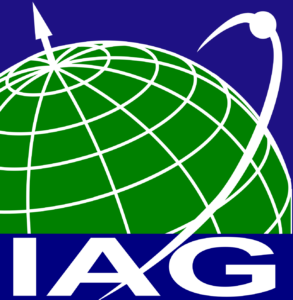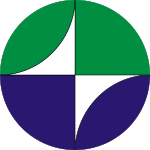Working Groups of Sub-Commission 2.5
SG 2.5.1: High-resolution altimetry for geodetic,oceanographic, cryosphere and hydrology studies (HRA)
Chair: Luciana Fenoglio-Marc (Germany)
Vice-Chair: Ole Andersen (Denmark)
Terms of Reference
The mapping of the surface water elevation (SWE) at high resolution in space and time has been a goal of geodetic, oceanic and hydrologic scientific communities. Satellite altimetry global observations of high spatial and temporal resolution are required to understand the climate-related oceanic and hydrologic dynamics, which involve small-scale processes and their interaction with larger-scale dynamics. In the ocean, small-scale processes are related to meso- and sub-mesoscale ocean eddies, to internal tides and internal waves, to the cross-shelf interaction between coastal regions, open oceandynamics and ecosystem. The dynamical processes in coastal oceans and estuaries are responsible for the along-shore distribution of nutrients and pollutions. On land, the small-scale processes relate to river dynamics and river discharge of water and nutrients from land into oceans, to extreme hydrological events and to climate change in inland waters. In the cryosphere, small-scale processes relate to dynamics of land ice and sea ice change. High-resolution altimetry (HRA) also provides improvement of bathymetry and geoid at small scales.
New technologies, like Ka-band in pulse-limited altimetry and Delay Doppler (DD), with one or two antennas in Synthetic Aperture Radar (SAR) and SAR-interferometric(SARin) modes, with unfocused and fully focused (FF-) SAR processing for CryoSat-2,Sentinel-3 and Sentinel-6 missions, provide today the highest accuracy and along-track resolution. Moreover, the Surface Water and Ocean Topography Mission (SWOT) is offering a unique contribution by providing observational evidence of currently unobserved wavelengths between 100 km and 15 km.
In light of the above rationale, HRA is proposed to investigate the development allowed by high-resolution altimetry in 1-D and 2-D fields. Mechanism of operations will be under IAG structure, with an elected International Governing Board andcoordinated peer-reviewed projects.
Objectives
HRA is a scientific and independent entity organized by the international scientificcommunity. HRA will host and support peer-reviewed community proposed “projects”intending to:
- Provide a forum for scientific exchange on enhanced usage of past and future altimetry data to improve the understanding of small-scale signals.
- Support discussions on innovative interdisciplinary scientific research and applications.
- Provide training courses for scientific users during IAG and IUGG general assemblies.
An initial list of possible “projects”, may include, but is not limited to the following:
- Enhanced processing of high-resolution altimetry along-track in SAR mode and comparison of available techniques (e.g., FF-SAR, LRMC, Unfocused SAR and ReducedSAR).
- Understanding of the SWOT signal outputs and realistic errors, and conducting calibration/validation of the observations.
- High resolution altimetry in open seas to study eddy dynamics and related vertical processed with exchanges of heat and carbon between the ocean and the atmosphere.The assimilation in high-resolution ocean models is recommended.
- High resolution altimetry in coastal zones and estuaries to study dynamics of exchanges in the river estuary and open ocean continuum. The assimilation in high-resolution hydrodynamic models is recommended.
- High resolution altimetry in rivers to study river dynamics and river discharge. The assimilation in hydrodynamic model is recommended.
- High resolution altimetry in lakes and wetland to study water mass change on land.
- High resolution altimetry on polar regions to study ice mass change and sea ice variation, ocean-cryosphere and solid Earth-cryosphere interactions.
- High resolution altimetry for determination of bathymetry and geoid.
- Innovative merging of products for interdisciplinary science and applications.
- Support activities for inter-comparisons of processing algorithms and evaluations of data products.
Members
Luciana Fenoglio-Marc (Germany); Chair
Ole Andersen (Denmark); Vice-Chair
Lifeng Bao (China)
Xiaoli Deng (Australia)
Denise Dettmering (Germany)
Taoyong Jin (China)
Cheinway Hwang (China-Taipei)
Armin Agha Karimi (Australia)
Chungyen Kuo (China-Taipei)
Jürgen Kusche (Germany)
Hyongki Lee (USA)
Eric Leuliette (USA)
Karina Nielsen (Denmark)
Fukai Peng (China)
David Sandwell (USA)
Walter Smith (USA)
C.K. Shum (USA)
Xiaoli Su (USA)
Christopher Watson (Australia)
SG 2.5.2: Synergistic Applications of Satellite Altimetry withOther Satellite Sensors and Physical Models (SASA)
Chair: Hyongki Lee (USA)
Vice-Chair: Chungyen Kuo (China-Taipei)
Terms of Reference
With advances in waveform retracking and new technologies, such as altimeters operating in Synthetic Aperture Radar (SAR, or Delay-Doppler) and SAR-interferometric(SARin) modes, satellite radar altimetry is a mature geodetic technique successfully providing surface elevation changes over, not only oceans, but also inland water bodies, ice-sheets/glaciers and topographic lands. In particular, satellite altimetry has been used to augment existing monitoring network or to derive new estimates with data from other satellite sensors or a physical model, especially over terrestrial surfaces. By adopting daily water levels created by integrating altimetry data and a hydrological model, daily-inundated areas can be generated with a data decomposition technique such as empirical orthogonal function analysis for finding correlation between altimetry-derived water levels and satellite imagery-derived inundated areas. The fusion of satellite laser altimetry (e.g., ICESat-2), optical imageries and models can be used to derive shallow water bathymetry (depth<40 m) and to reconstruct topography of a tidal flats, producing a seamless ocean-land topography. Altimetry in synergy with GRACE and GRACE-FO has also played a major role in monitoring mass changes of the ice sheets and glaciers of the world. Another class of sensors, which is potentially able to sense high temporal frequency signals, is the spaceborne Global Navigation Satellite System Reflectometry (GNSS-R). It measures the Earth surface from different constellations for sensors already inplace (e.g., GNSS). The NASA CYGNSS and the UK TechDemoSat-1 satellites both carry the GNSS-R receiver. The application of GNSS-R for altimetry offers a unique opportunity to monitor the ice sheets, sea ice, land cover, soil moisture, polar and coastal oceans. It is therefore important to promote innovative usage of altimetry data synergistically integrated with data obtained from other satellite sensors (e.g., optical/SARimaging sensors, laser altimetry, GRACE/GRACE-FO and GNSS-R) and physicalmodels in order to advance scientific studies and real world applications.
Objectives
To support synergistic applications of altimetry data with data from other satellite sensors and physical models, SASA intends to:
- Support collaborations among scientific users of altimetry and other satellite sensors– working groups from different sub-commissions.
- Merge altimetry-derived water levels with imaging sensor-derived river widths/inundated areas, in situ data, model outputs and GRACE/GRACE-FO data for riverdischarge estimation, reservoir monitoring and inundation mapping.
- Integrate altimetry data with hydrologic models to reduce uncertainties in model-derived streamflow;
- Use altimetry-derived water level based on flow correlation for evaluation of hydrological model for ungauged basins.
- Study geophysical processes, merging multi-mission radar altimetry and laseraltimetry (ICESat, ICESat-2), other geodetic data and SWOT interferometric altimetry in the future.
- Combine altimetry with GRACE and GRACE-FO data to estimate ice-sheet/glacier firn density, and to isolate contributions from Glacial Isostatic Adjustment (GIA).
- Map land ice and mountain glacier elevations using multiple radar altimetry missions.
- Use in situ/SNR and spaceborne GNSS-R altimetry/radiometry for monitoring coastal sea levels, inland water bodies, soil moisture, snow elevation changes and land/water classifications.
Members
Hyongki Lee (USA); Chair
Chungyen Kuo (China-Taipei); Vice-Chair
Lifeng Bao (China)
Xiaoli Deng (Australia)
Denise Dettmering (Germany)
Taoyong Jin (China)
Cheinway Hwang (China-Taipei)
Armin Agha Karimi (Australia)
Jürgen Kusche (Germany)
Eric Leuliette (USA)
Karina Nielsen (Denmark)
Fukai Peng (China)
David Sandwell (USA)
Walter Smith (USA)
C.K. Shum (USA)
Xiaoli Su (USA)
Christopher Watson (Australia)
SG 2.5.3: High Resolution Mean Sea Surface (MSS)
Chair: David Sandwell (USA)
Vice-Chairs: Ole Andersen (Denmark), Philippe Schaeffer (France)
Terms of Reference
Satellite radar altimeter measurements of sea surface heights have been continuously collected since the early 1990’s for two main purposes. The physical oceanography (PO) community has nearly 30 years of measurements along the 10-day repeat groundtracks of TOPEX/Poseidon, Jason-1/2/3, and Sentinel-6 missions. In addition, there has been a similar 30-years of data collected along the 35-day repeat ground tracks of ERS-1/2, Envisat and SARAL, and 3–5 years of 27-day repeat ground tracks of Sentinel-3A/-3B interleave orbits. These two tracks have been used to monitor global and regional sea level rise and provide a highly accurate framework for time variations in the mean sea surface (MSS) (https://www.aviso.altimetry.fr/en/data/products/auxiliary-products/mss.html, https://www.space.dtu.dk/english/research/scientific_data_and_models/global_mean_sea_surface).
Higher spatially sampled altimetry data have been also collected along orbits having much longer repeat times greater than 180 days from Geosat, ERS-1, Cryosat-2, SARAL/Altika, and Jason-1/2 (extension of life). While these data have poor temporal resolution, the high spatial resolution provides new information on the marine gravity field (https://topex.ucsd.edu/grav_outreach/).
These two kinds of altimetric missions are fundamentally complementary. Exact Repeat Missions (ERM) allow to access to an accurate determination of the steady state of the ocean, and Geodetic Missions (GM) provide the knowledge of the shortest topographic structures to a few kilometer. In addition, new altimeter technologies such as the Surface Water and Ocean Topography (SWOT) mission collect data at both high spatial and high temporal resolution. Our study group is developing a MSS to provide a validation surface for these new measurements.
This group listed below has been collaborating for the past three years on the development of this MSS by comparing largely independent developments. There area number of important challenges including: the definition of the averaging time for the MSS; the methods of combining the short wavelength information from the high spatial density measurements with the sparse framework provided by the PO missions; and extending the MSS into the Arctic where the spatial and temporal coverage is less than optimal due to sea ice cover.
Objectives
To provide a long-term reference sea surface for the physical oceanographic and geodetic communities as well as for CAL/VAL of new altimeter missions, the MSS study group intends to:
- Support discussions and collaborations in the international scientific community on the development of a high resolution MSS.
- Develop a consensus global MSS by combining the long-term framework from exact repeat altimeter missions including: TOPEX/Jason, Envisat/SARAL and Sentinel-3 with the high spatial resolution data provided by Geosat, Cryosat-2, SARAL and Jason-1/2/3 (extension of life).
- Hold regular meetings to compare and contrast MSS models developed at CLS,DTU and SIO.
- Distribute the consensus MSS model(s) to the physical oceanography, geodetic, offshore industry and altimetry communities.
- Focus, in particular, on the development of a MSS for the upcoming SWOT mission to provide calibration and validation early in its mission.
Members
David Sandwell (USA); Chair
Ole Andersen (Denmark); Vice-Chair
Philippe Schaeffer (France); Vice-Chair
Adili Abulaitijiang (Germany)
Xiaoli Deng (Australia)
Bruce Haines (USA)
Cheinway Hwang (China-Taipei)
Per Knudsen (Denmark)
Eric Leuliette (USA)
Yuanyuan Jia (USA)
Isabelle Pujol (France)
Walter Smith (USA)
C.K. Shum (USA)
Jinbo Wang (USA)
Daocheng Yu (China)
Shengjun Zhang (China)
Mao Zhou (China)
SG 2.5.4: The International Altimeter Service (IAS) Planning Group
Chair: Xiaoli Deng (Australia)
Vice-Chairs: C K Shum (USA), Jérôme Benveniste (Italy), Stefano Vignudelli (Italy)
Terms of Reference
Satellite altimetry has demonstrated seminal research in interdisciplinary Earth sciences, including general ocean circulation, sea-level science, sea-state, global gravity field models (EGMs), bathymetry and marine geophysics, ocean tides, ice reservoir mass change, polar and coastal and oceanography, hydrology and water cycles, low altitude total electronic contents, land and ice digital surface models, near-surface soil moisture, and land surface deformation. The major geodetic and geophysical contribution of satellite altimetry has been and will be the refinement of the global high-resolution gravity field and seafloor bathymetric models.
At present and since late 1970’s, multiple national and international space, defense, oceanic, atmospheric and meteorological agencies, Universities, industries, and other organizations have collectively launched satellite radar and laser altimetry missions.These constellations of altimeter missions enable the generation of multi-decadal, continuous, and uniform geophysical and climate data records at unprecedented spatiotemporal resolution and accuracy. Innovative instrumentation advanced from pulse-limited to Delay-Doppler or SAR, to wide-swath (SWOT mission), to multi-beam photo counting laser altimetry (ATLAS), and to the more recent exploitation of SoOP (Signals of Opportunity) satellite sources in bistatic radar enabled satellite altimetry, including L-band GNSS-Reflectometry enabled altimetry. Current pulse-limited and SAR altimetry missions are operational, with other contemporary scientific missions poised to be operational.
The currently flying and planned altimetry missions are abundant in the decades to come. To extend the multi-altimetry climate record, it necessitates collaborations beyond a single space agency for calibration and validation of multiple altimetry instrument, and orbits, media and geophysical corrections, to assess potential inter-mission instrument biases, their drifts, and overall consistency of the interdisciplinary data products, including multi-decadal elevation evolutions of ice-sheets, mountain glacier-s/ice caps, ice-shelves, and sea-/Lake-ice, Lake water and river levels, and solid Earthdisplacements.
The IAS Planning Group proposed the establishment of an IAS in 2019 IUGG,Montreal, and the IAS Pilot Service was accepted as an IAG-ordained service in July 2023. It would be overachieving the goal of this IAS planning group to recommend astrategical plan and to continue deliberating the feasibility of eventual establishmentof the IAS under IAG.
Objectives
As a dedicated IAS planning group, it intends to:
- Convene annual workshops and conducts dialogs with scientists and key technical curators of existing altimeter data product services, to assess the rationales on establishing a potential IAS would be mutually beneficial to them and to theirsponsoring agencies.
- Continue to confirm a list of key members at the end of the IAS Planning Groupactivity period, towards a potential next phase of IAS activities.
- Seek and disseminate ideas from the Planning Group, IAS Pilot Service and the community to identify potential new and useful altimetry data products, with the associated data retrieval and visualization tools.
- Pursue new potential altimetry mission data product processing and validation collaborations with, for example, Chinese satellite altimeter missions, such as HY2Ahistoric data re-processing, and processing strategies for HY2B/2C/2D in the future; as well as potential GNSS-R altimetry data products from existing and future LEOs (CyGNSS, Triton, HydroGNSS, PRETTY, and possible commercial LEOs, including Spire constellation).
- Improve IAS objectives through experience of IAS Pilot Service, a renewed strategy, new innovative technologies, and availability of increased numbers of contemporary satellite altimetry constellations.
- Seek a consensus among the IAS Planning Group members on the feasibility assessment to establish the IAS during the next phase.
Members
The group has 32 confirmed international members from diverse disciplines in geodesy, geophysics, oceanography, hydrology, cryosphere, solid Earth and climate science.They may be members of altimetry mission science teams, mission advisory groups, organised interdisciplinary altimetry communities (e.g., IAG commissions and sub-commissions, OSTST, coastal altimetry, CCI/MEaSUREs projects), and stakeholders of new concepts of satellite altimetry and their applications, including altimetry from signals of opportunities.
Xiaoli Deng (Australia); Chair
C K Shum (USA); Vice-Chair
Jérôme Benveniste (Italy); Vice-Chair
Stefano Vignudelli (Italy); Vice-Chair
Mohammad Al-Khaldi (USA)
Ole Andersen (Denmark)
Lifeng Bao (China)
Jean François Crétaux (France)
Denise Dettmering (Germany)
Luciana Fenoglio-Marc (Germany)
James Garrison (USA)
Cheinway Hwang (China-Taipei)
Sinem Ince (Germany)
Yongjun Jia (China)
Yuanyuan Jia (USA)
Taoyong Jin (China)
Chungyen Kuo (China-Taipei)
Jürgen Kusche (Germany)
Hyongki Lee (USA)
Weiqiang Li (Spain)
Xiaopeng Li (USA)
Hossein Nahavandchi (Norway)
Marc Naeije (Netherlands)
Jason Otero Torres (USA)
Fukai Peng (China)
Marco Restano (Italy)
Richard Salman (USA)
David Sandwell (USA)
Christian Schwatke (Germany)
Yohanes Budi Sulistioadi (Indonesia)
Pieter Visser (Netherlands)
Xiaoyun Wan (China)



